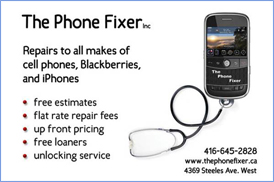You Know, Rogers, Telus and Bell All Have “4G” Networks, Too
The Canadian cellphone market is a strange one. Everyone says there is an oligopoly, where only three companies control the industry, and this is largely true. They say that prices are exorbitantly high and that three-year contracts are indicative of an industry without true regulation.
All of these positions have been posited many times before, and it’s not my place to refute them. I agree with some of them, but after spending some time communicating with a number of representatives from each company, I find it difficult to outright say that they’re all out to rob you and leave you high and dry.
Rogers, Telus and Bell individually operate 3G+ networks (though Telus and Bell deployed their HSPA+ towers together, they’re still obviously routed through separate networks) and all support speeds of up to 21Mbps. Bell recently upgraded a portion of their downtown Toronto capacity to 42Mbps.
So, over the past couple weeks, with CES freshly in our hearts and minds, I find it fascinating that none of the Canadian carriers have followed their American counterparts by launching “4G” networks.
Let’s be clear here: the only network in the US that has legitimately launched a next-generation, or 4G network, is Verizon (and to a lesser extent, MetroPCS). Their LTE deployment is currently limited, and is only used for data, but the technology is still way beyond the latency and speed capabilities of UMTS, the data portion of current HSPA+ (3G+) networks.
Rogers has already initiated testing of their burgeoning LTE network, albeit on a scale that can only be considered highly limited. Their current test is on the AWS spectrum (1700/2100Mhz, same as WIND and Mobilicity) and is only in Ottawa. The spectrum needed for an actual LTE deployment, 700Mhz, hasn’t even been auctioned off yet in Canada.
Bell is also promising rolling out an LTE overlay over their existing CDMA and HSPA networks, perhaps, like Verizon, utilizing their current low-bandwidth spectrum for voice and carrying only data on the LTE band.
That being said, Bell and Telus only launched their HSPA+ networks in late 2009, and have since been obliterating the market with device launches, blazing mobile internet speeds (up to 42Mbps) and minimal latency.
Rogers, on the other hand, are, like AT&T, saturated in parts of the country, and their performance often suffers as a result. Both networks have fared far better than the aforementioned US carrier in terms of maintained performance, but the comparison isn’t fair, since the load on AT&T’s network in major cities is higher than on Rogers.
Are any of the big three carriers going to change their tune and begin marketing their current networks as “4G?” It’s unlikely, but with the growing popularity of discount carriers WIND Mobile and Mobilicity, anything to justify the inflated monthly price and limited servie will likely help them in the long run. Bell already advertises itself as “Canada’s Best Network” and Rogers as “Canada’s Reliable Network,” so the addition of a “4G” banner may only serve to confuse things.
Like so many Canadian sensibilities, the entrenched carriers would rather play it safe. Customer contracts are longer and there is far less movement between carriers as a result due to less price competition. Along with increasing bandwidth, they’re lowering caps and making it more expensive to do anything at those speeds. More and more often I am noticing my Rogers 3G signal dropping to 2G EDGE speeds due to tower saturation. The blazing 3-6Mbps download speeds I achieved when Bell rolled out its network have slowed to a consistent 1-2Mbps in some parts of the city. If the companies are going to deal with the influx of Canadian mobile consumers, they need to deploy more towers and increase current sector capacity, or we’re going to have big cities like Toronto performing like AT&T during a snowstorm.
So, fake 4G or real 4G, it’s in their best interest to stir the pot a little: the stuff on the bottom might get burned.
-
Puleen Patel
-
P Jamieson










